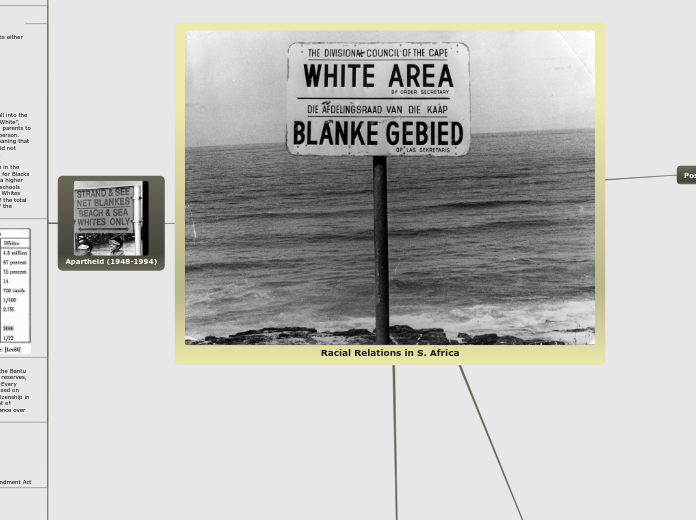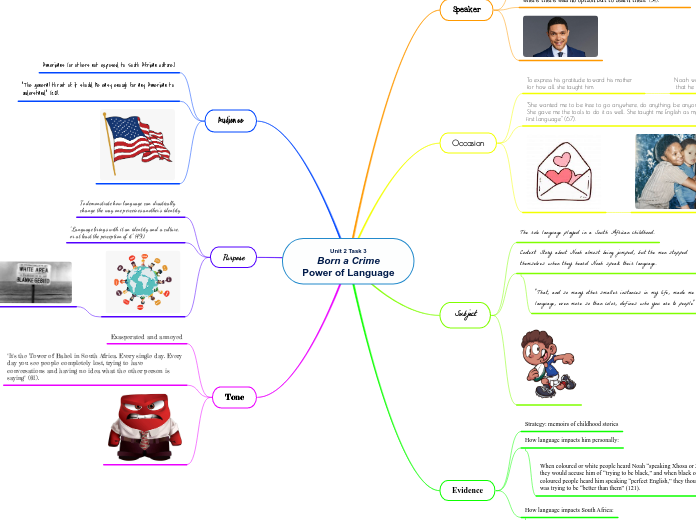Racial Relations in S. Africa
Apartheid (1948-1994)
Non-Whites in S. Africa were stripped of citizenship and neccessities, e.g. medical care, schools, etc.
03. 21. 1960 – The Sharpeville Massacre takes place
On March 21st, 1960, many Blacks held demonstrations against the “Pass Laws”, laws which required all blacks aged sixteen and up to carry passbooks containing their full name, date of birth, photographs, etc. Around 5,000 to 10,000 people had approached a police station, offering themselves up for arrest. The group had not been carrying their passbooks in protest of the laws. The South African government had declared a “State of Emergency”, which allows police to use physical violence on protesters. The state of emergency had lasted 156 days, with 69 deaths and 187 injured.
1953 Public Safety Act & Criminal Law Amendment Act
State of Emergency - Should a state of emergency be issued by the South African Gov't, Police were permitted to use violence on protesters.
The penalties for protesting were very heavy fines, imprisonment without trial (those who were tried received death sentence, banishment from South Africa, or life imprisonment.
In the year 1951, there was a basis established by the Bantu Authorities Act for ethnic government in the African reserves, called "homelands" which were independent states. Every black person had been assigned to a "homeland" based on their ethnic origins. With this, they had lost their citizenship in South Africa, This also meant losing all and any right of involvement with the Parliament, which held dominance over the "homelands".
1950 – Every resident in South Africa was sorted into either one out of three categories.
- White
- Black
- Colored
If someone is neither white nor black, they would fall into the “Colored” category. For someone to be considered “White”, there were criteria, such as the requirement of both parents to be White, and if they were perceived to be a white person. Mixed-race marriage was also prohibited by law, meaning that a white could not marry a black, a black person could not marry an Indian, or any other combination of races.
Blacks were also subject to higher taxes, as shown in the chart below. This chart also shows the quality of life for Blacks compared to Whites, which included fewer doctors, a higher mortality rate among infants, fewer, more crowded schools with around 60 students to 1 teacher, etc. Although Whites were the minority of the population, they had ¾ of the total national income, while Blacks had less than 20% of the national income.
1948 – All Blacks who were sixteen years of age or older were legally required to carry on their person at all times a “Pass Book”. This document contained information such as their full name, date of birth, photographs, etc. If a black person was to travel anywhere outside of their Bantustan, or “Homeland” , they were required to carry this document. If someone fails to present their passbook upon the officer’s request, the resulting consequence would be jail time.
With the introduction of Apartheid, separate facilities (i.e. schools, public toilets, train stations, etc.) had been set up for use by Whites and Colored, intended to reduce contact between races. In addition to that, there were jobs sanctioned for Whites, and Non-Whites were not permitted to run businesses in designated White areas. Usually, facilities which had been set aside for use by non-whites were lower quality than those intended for use by whites.
"Apartheid" (meaning aparthood )was a system of Racial Segregation inteded to keep different races apart from eachother, which had been- in use from 1948-1994
Subtopic
Significance and Scope
This has an effect on all people in general in South Africa, historically and now, during the Colonial Era, Apartheid, and Now, as it had changed during the past few hundred years. For example, after Apartheid was lifted, many White South African farmers had been attacked
Colonial Era
In addition to all of those, Non-White residents in South Africa were subjected to much higher taxation rates compared to those for whites.
Under Dutch Colonial Law, there were many laws that promoted racism and discrimination, examples being that Blacks were not permitted to walk on sidewalks, paid much higher taxes than Whites, and were not allowed to go anywhere in some parts of the country.
A slave was defined as a piece of property which could either be traded, purchased, or sold.
The first slaves to be brought in South Africa were non-muslim slaves from India, which at the time was ruled by Muslims.
In 1721, a slave trading station had been established, but had only been in use for ten years (until 1731)
There were also other places where slaves were taken from and sent to present-day South Africa, such as Madagascar, where slaves were bought between the years 1731 and 1765.
An example of racial discrimination would be the food rations during the Siege of Ladysmith.
The race groups which recieved the largest rations were whites, while the Blacks only recieved between 1 to one-quarter pounds of horse meat.
During the colonial era, slaves from various origins had been brought over to the land that would become South Africa for farming and other purposes to work under the settlements.
Post-Apartheid (1994-Present)
Even after the fall of Apartheid, Racism can still be a problem, where all races in South Africa have been the subject. Whites, Blacks, Indian, Chinese, Etc. in forms of violence, homicide, hate speech, etc.
Racism against Indians and Asians
The majority of Indian South Africans are in KwaZulu Natal, where sentiments against minorities had become increasingly concerning. There are both examples of hate speech and violence against Indians in South Africa. An example of hate speech against South Africans who are of Indian descent is the words of Phumlani Mfeka, a KwaZulu Natal businessman, who is also the spokesman for the "Mazibuye African Forum" published a letter which claimed that Indian South Africans do not have any rights to owning property or citizenship.He had posted on his Twitter account "A Good Indian is a dead Indian". Phumlani Mfeka had also been barred from making remarks against Indians by the South African Court.
There had also been attacks on the Chinese community in South Africa.
Anti-Semitism
10
Anti-Semitism in South Africa has been in existence since the 1930's, when the Nazi movement had maintained dominance over Germany from 1933-1945. One of the many reasons of this happening was due to the Germans being an enemy of Great Britain.
In South Africa, there were also many sports clubs which had a policy which barred Jews from entering until recently. The D.F. Malan National Party was very closely associated with Nazi laws and policies. One notable action of the D. F. Malan National Party was the Aliens Act, which stopped all Jewish migrants from Eastern Europe from entering South Africa.
An area known as District Six was where many Jews had lived, prior to their forced eviction, as the land covering "District Six" would be used for a White-Only development.
Hendrick Verwoerd, who had designed the Apartheid in South Africa, had obtained a psychology degree while studying abroad in Germany. H. Verwoerd had also protested allowing Jewish refugees who had come from Germany into South Africa, in the fear that Jewish residents intended to
A) Spread communism throughout the world
B) Overtake Protestant businessmen.
The Aliens Act's definition of Jews was anyone whose parents were of even partial Jewish ancestry, ignoring their religious beliefs.
During the Apartheid era, in 1956, Nelson Mandela was tried for treason, accompanied by a group which consisted mostly of Jewish men and women. There were also accusations of the group conspiring to overthrow the current government.
Post-Apartheid, there are still examples of Anti-Semitism in South Africa. One notable example is the synagogue bombings, which are believed to have been done by a vigilante group known as P. A. G. A. D. (People Against Gangsterism and Drugs), who are known for killing gangsters and setting fire to their homes. There are other examples, such as the Western Cape Leader, Marius Fransman who, in 2013, claimed that “98% of land and property owners were white and jewish”. Another example was a broadcast by the radio station "Radio 786", who had broadcasted a programme which denied that the Holocaust ever happened.
Anti-White Racism
There have been many incidents of racism against white people, which is often ignored in South Africa. There are some notable incidents of violence against white people, such as one incident which occurred in 2004 where a man had killed and abducted a woman , her daughter, and her daughter's grandmother, due to their race.
There have also been notable examples of hate speech, which very often talk about killing and/or torturing white residents in South Africa, such as the leader of the "Economic Freedom Fighters", a political party in South Africa, in 2018 promoted violence against white residents in the country.
Another example would be the killings of South African farmers. These events have had many noticeable reactions, such as the internet chatroom "AfriForum" who protested the deaths of the farmers in question, claiming that the attacks were racially motivated. This internet chatroom had also denied that Apartheid was a crime against humanity.
Anti-Black Racism
Although there is no legal form of racial segregation, there is still incidents of overt racism in South Africa, such as a real estate agent who had previously lived in Durban, SA, who had made a comparison of black residents entirely to "dirty monkeys who littered on the beaches" , which were previously set aside for use by whites only.
The consequences of this were her (the real estate agent) being fined upwards of USD 13,000, two years' prison sentence, multiple death threats, etc.
In addition to hate speech, there has also been racially motivated violence against blacks in South Africa, including two white men in 2016 who had violently beaten a black man for allegedly trespassing on private property. The two men had been imprisoned for their crimes, and one of them had also received their sentence for destroying evidence of anything happening in the first place.









